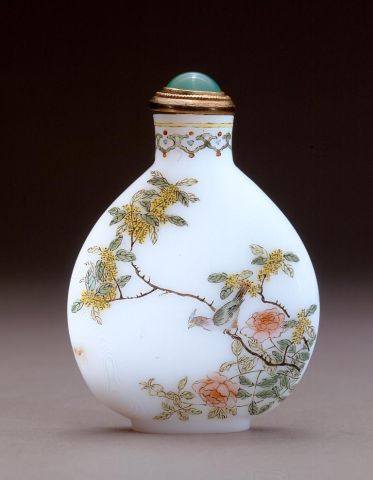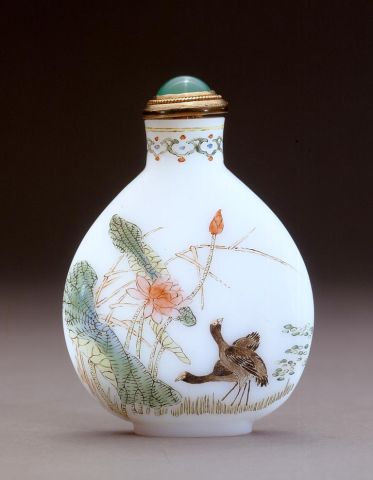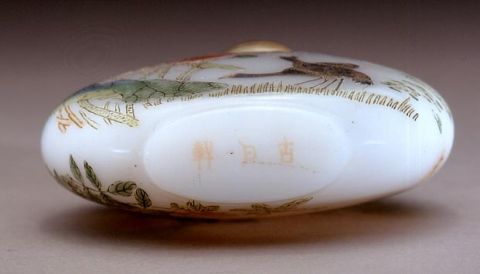


Bottle ID: 00449
YANGZHOU, WHITE, BIRDS, TREES & FLOWERS
Date: 1770-1820
Height: 63 mm
Glass, of flattened rounded form, the shoulders tapering to a neck with slightly everted mouth, and resting on a flat footrim, the milk-white glass decorated in famille rose enamels, with on one side a bird perched on the branches of a leafy tree with peonies growing to one side; the reverse with two geese wading in the marsh with lotus flowers, leaves and pods growing beside them; the neck with a circular band above trefoil scrolls; the base with a three character Guyue Xuan mark.
Attributed to Yangzhou.
Similar Examples:
Crane Collection no. 233.
Parke-Bernet Galleries Inc., New York, December 2, 1969, lot 17A, Collection of Mrs. Elmer A. Claar, Part One.
Christie, Manson & Wood, St. James's, London, June 18, 1973, lot 94, The Ko Family Collection, Part III.
Provenance:
Asian Art Studio
Sotheby's, Hong Kong, October 30, 2000, lot 567
Guo'an Collection, Inventory no. 53
Jade Co., Geneva, Switzerland, 1965
Exhibited:
Annual Convention ICSBS Toronto, October 2007
Published:
JICSBS, Winter 2008, p. 10, figs. 12a and 12b
This delicate, but finely enameled bottle illustrates admirably that high quality enameling was being produced outside both the Beijing Palace and the Yuanming Yuan. Other known centers of enameling included Yangzhou, Guangzhou, and Yunnan, in addition to the private workshops in Beijing.
The Yangzhou Hua Fang Lu mentions an enamel artist named Wang Shixing, who worked from sometime in the Yongzheng period into Qianlong's reign. The Yangzhou Hua Fang Lu quotes as follows:
"He had many friends, and his fame spread throughout the land. In the Capital his fine craftsmanship was praised, this artist being known in Peking as the enamel-ware king."
This quote reveals much. Wang had "many friends" (or clients) showing that even in the first half of the eighteenth century, he must have already been operating a lucrative commercial enterprise. This, in turn, suggests that enameled objects were already popular outside the Court. Wang's clients in Beijing (Peking) would have been exposed to his work, which must have been available for purchase in the City, as he was known there as "the enamel-ware king". This implies that in Beijing, if a wealthy collector wanted a high quality enamel piece, it could be commissioned from Wang Shixing in Yangzhou.

 English
English 中文
中文